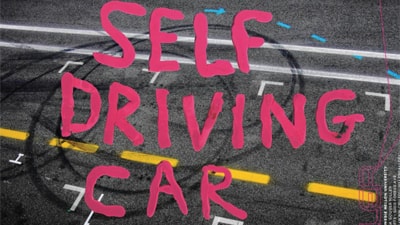“Self Driving Car” Opens March 18
Emerging Artists Forge Own Paths With New Multimedia Work
By Lauren Goshinski / 412-268-1533 / laurengo@andrew.cmu.eduCarnegie Mellon University Master of Fine Arts (MFA) candidates will present their culminating work in “Self Driving Car,” the School of Art’s 2016 MFA Thesis Exhibition, March 18 – April 10. An opening reception will be held from 6 - 8 p.m. Friday, March 18, in CMU’s Miller Gallery.
Artists Dan Allende, Zhiwan Cheung, Nima Dehghan Ada-Scarlett Hopper, Jesse Kauppila, Tucker Marder and Daniel Pillis present digital prints, sculptures, site specific installations, videos, performances, and interactive pieces using augmented and virtual reality. The exhibition is free and open to the public. Gallery hours are 12 – 6 p.m., Tuesday – Sunday.

“In this MFA exhibition, we will experience: a belly aching performance full of gutwrenching bathos; a heartfelt search for identity within and beyond ethnicity; concern with exile, diaspora, displacement and virtuality; the body in extremis; surprising collisions between human culture and animal behavior; and the interface between personal and technological histories,” said John Carson, head of the School of Art.
New York-based art critic and journalist Brian Boucher, senior writer at Artnet, and Eric Shiner, executive director at Pittsburgh’s Andy Warhol Museum, will bring their insight to the works on view by leading public critiques with the artists from 6 – 9:30 p.m., Thursday, March 24, and Thursday, March 31.
For those interested in getting their bodies a little closer to art, Allende will lead a free maskmaking and belly dancing workshop at noon on both Thursdays, teaching participants how to turn their bodies into masks through plaster casting. Also expanding the traditional gallery format, Pillis’ thesis work invites visitors to experience an “artificially intelligent archive,” employing augmented reality located outside of the gallery. Text 908-902-9559 for more information.
“The title of our show is a reflection of the culture of CMU, meant to humorously mimic technological interests that are prevalent here,” Allende said. “The title is meant to bring attention to the art program in a school known for its STEM.”
About the Artists:
Dan Allende
Sometimes I am sitting in my car after pulling out of Wendy’s drive thru, sipping on a cherry coke and munching on a hamburger, when I get a rumbling deep in my belly. In this situation most would typically associate the disturbance with indigestion, but as a frequent visitor to Wendy’s, I understand it as the beginning of a creative awakening. The belly (gut) is the home of the irrational drive powerful enough to supersede our higher brain function. This body of work is an homage to the origins of the movement and to the object of my desire: Wendy ... You’ve always been there for me ... (After Letters to Wendy’s by Joe Wenderoth, 1997).
Zhiwan Cheung
The intersection of national identity and the personal psyche is complex, not always clear nor fixed; as an artist, I probe the paths and how and where they join and diverge. As an odyssey toward a home that does not exist, a rite of passage with no destination, I use my work to search for a critical understanding of an impossible homecoming. Through sculpture, film and performance, I focus on the meaning and space between identities, examining the feeling of a liminal displacement.
Nima Dehghani
Nima works predominantly in the medium of performing arts and digital media, and his goal is to find the most effective ways to influence the audience using new media. His research revolves around the core of Middle Eastern studies, social behavior in online networks and performativity of social actions. Humans, communication, individual conflicts and social discriminations, with allusions to politics, have been the subject of most of his works.
Ada-Scarlett Hopper
Through various media, most currently those of sculpture, performance and photography, Ada Hopper uses her diverse background in the study of medicine, practice of dance, and engagement in the visual arts to explore many philosophical issues relevant to understanding the vast spaces that can exist between extremes of what is and what is not. Hopper’s most current works strive to understand how movement, time, and machines frame our biological and philosophical existence.
Jesse Kauppila
I love technology, cities and the modern world, but I grew up in stunning rural Vermont in a family that values craft and education. This experience led me to pursue a career as first a printer, then an art historian, and now an artist. I explore how a variety of technologies and concepts shape our experience of the world. I am currently working with the relationship between abstract thinking and gameplay.
Tucker Marder
I grew up diving in a saltwater creek 100 miles east of New York City. This creek was home to a particularly humorous ecosystem. From these early encounters with the natural world, I developed a vocabulary for making art, engaging with the humor of animal behaviors to encourage empathy for the non-human. But the sense of absurdity with which I approach making art about nature derives not just from the animals themselves, but the predicament in which we find them. I believe that ecological responsibility is best instilled through exuberance. I have developed an environmental ethic that promotes optimism and engagement rather than depression and paralysis.
Daniel Pillis
Daniel Pillis makes work about the history of technology, exploring the overlap and tension between human existence and artificial forms of life. Computer graphics as a concept, archives of human experience, as well as the histories of individuals who have made technological progress are all dominant themes in his installation, animation and sculptural inquiries.
Media Contact:
Pam Wigley / 412-268-1047 / pwigley@andrew.cmu.edu